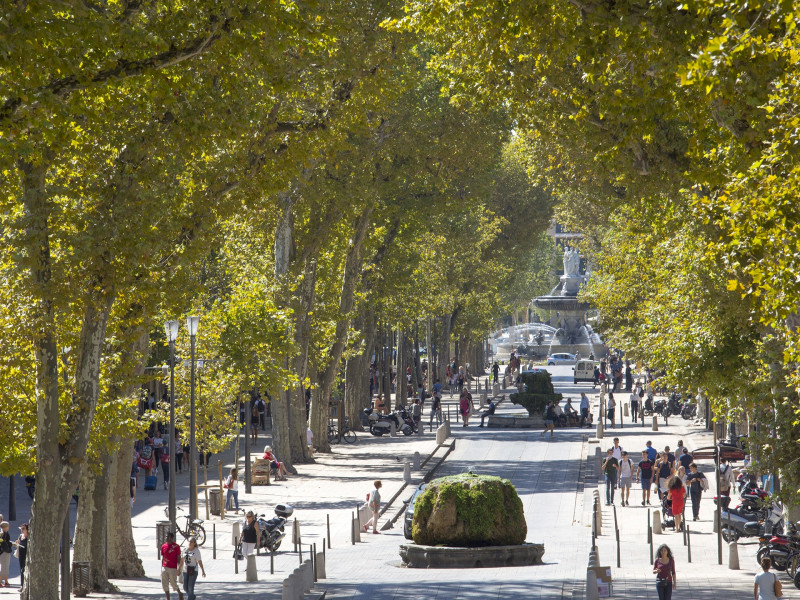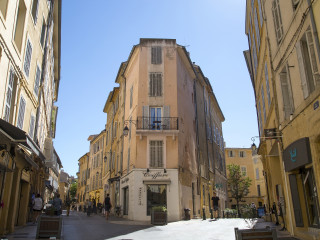The Cours Mirabeau
Historic site and monumentPresentation
440 meters long and 42 meters wide, the Cours Mirabeau is the link between the Mazarin district to the south and the old commercial city to the north. Today, it is one of the most frequented and lively places in Aix en Provence.
440 metres long and 42 metres wide, Cours Mirabeau links the Mazarin district to the south with the old market town to the north.
Today it is one of the busiest and most lively places in Aix en Provence. With its plane trees, fountains and cafes, the Cours is extremely popular with tourists and residents alike.
Cours Mirabeau was made when the city was enlarged in the 17th century on the orders of Archbishop Mazarin and at the request of bourgeois home-owners who wanted a thoroughfare for carriages and pedestrians.
The road followed the line of the former ramparts, and the richest noble families had elegant houses built along it to show off their success, sometimes ostentatiously.
At No.4 is Hôtel de Villars, built in 1710 and named after the Governor of Provence. Its frontage has a fine entrance framed by four columns with Doric capitals.
Hôtel Isoard de Vauvenargues, at No.10, was built in around 1710. Its plain frontage hides a lavish decor, and its staircase has a metalwork railing from the late 17th century.
At No.20, Hôtel de Forbin is one of the largest on the Cours. It was built in 1656 with Aix stone from the Bibémus quarries, to the plans of Pierre Pavillon. Its beauty derives from the simplicity and symmetry of its layout. It has played host to some distinguished guests: the dukes of Burgundy and Berry, the grandsons of Louis XIV, and Napoleon's sister Pauline Borghese, among others.
The magnificence of Hôtel Maurel-de-Pontevés, at No.38, also known as Hôtel d'Espagnet, reflects the social success of its owner, Pierre Maurel. Originally a cloth merchant, he gained a noble title and his mansion was one of the first to be built in the Mazarin district from 1647 onwards.
The balcony, supported by Atlases, is typical of Aix Baroque art.
Hôtel d'Arbaud-Jouques at No.19, built around 1700, is one of the most beautiful on the Cours, with a façade entirely in dressed stone and an entrance which is probably the most ornate in Aix.
At No.53 bis, on the site of Hôtel de Gantès, Les Deux Garçons Café (destroyed by a fire in November 2019) has been an "Aix institution" since the beginning of the 19th century, and Cezanne was a regular customer there. Next to Passage Agard, at No.55, is the house where Paul Cézanne lived as a child.
There are four fountains along Cours Mirabeau. The most imposing is probably the Rotonde fountain. Its construction in 1860 marked a turning point: not only were its dimensions exceptional for the city, but it was also the first to have a cast-iron basin. The three statues adorning the fountain recall the city's principal professions: Law (facing Cours Mirabeau), Agriculture (facing Marseille) and Art (facing Avignon).
The fountain marked the symbolic entrance to the modern city, without ramparts or gates, and open to the world. Since then Aix has grown and the "Great Fountain" is in the centre of the city.
Built in 1691 by Laurent Vallon, the Nine Cannons Fountain replaced a watering fountain where flocks were brought to drink as they migrated, before Cours Mirabeau was built. Its water was used by the nuns of St Ursule (Lycée Mignet) and then by the Benedictines. The vegetation, encroaching little by little, makes it difficult to identify the sculptures. However, it was listed in 1929. Further on, the Hot Water Fountain, known as the Mossy Fountain because of the thick moss covering it, is the one where the water from the Bagniers spring flows at a temperature of 18°C. This was the first fountain built on the Cours and it is still fed by the spa water.
At the top of Cours Mirabeau is King René's fountain, designed in 1819 by Pierre-Henri Revoil. The statue which adorns it is the work of David d'Angers. It shows Good King René‚ wearing the crown of the Counts of Provence, holding in his hands the sceptre and the Muscat grapes which he introduced to Provence, and with books at his feet (to indicate his patronage of the arts and learning).
Today it is one of the busiest and most lively places in Aix en Provence. With its plane trees, fountains and cafes, the Cours is extremely popular with tourists and residents alike.
Cours Mirabeau was made when the city was enlarged in the 17th century on the orders of Archbishop Mazarin and at the request of bourgeois home-owners who wanted a thoroughfare for carriages and pedestrians.
The road followed the line of the former ramparts, and the richest noble families had elegant houses built along it to show off their success, sometimes ostentatiously.
At No.4 is Hôtel de Villars, built in 1710 and named after the Governor of Provence. Its frontage has a fine entrance framed by four columns with Doric capitals.
Hôtel Isoard de Vauvenargues, at No.10, was built in around 1710. Its plain frontage hides a lavish decor, and its staircase has a metalwork railing from the late 17th century.
At No.20, Hôtel de Forbin is one of the largest on the Cours. It was built in 1656 with Aix stone from the Bibémus quarries, to the plans of Pierre Pavillon. Its beauty derives from the simplicity and symmetry of its layout. It has played host to some distinguished guests: the dukes of Burgundy and Berry, the grandsons of Louis XIV, and Napoleon's sister Pauline Borghese, among others.
The magnificence of Hôtel Maurel-de-Pontevés, at No.38, also known as Hôtel d'Espagnet, reflects the social success of its owner, Pierre Maurel. Originally a cloth merchant, he gained a noble title and his mansion was one of the first to be built in the Mazarin district from 1647 onwards.
The balcony, supported by Atlases, is typical of Aix Baroque art.
Hôtel d'Arbaud-Jouques at No.19, built around 1700, is one of the most beautiful on the Cours, with a façade entirely in dressed stone and an entrance which is probably the most ornate in Aix.
At No.53 bis, on the site of Hôtel de Gantès, Les Deux Garçons Café (destroyed by a fire in November 2019) has been an "Aix institution" since the beginning of the 19th century, and Cezanne was a regular customer there. Next to Passage Agard, at No.55, is the house where Paul Cézanne lived as a child.
There are four fountains along Cours Mirabeau. The most imposing is probably the Rotonde fountain. Its construction in 1860 marked a turning point: not only were its dimensions exceptional for the city, but it was also the first to have a cast-iron basin. The three statues adorning the fountain recall the city's principal professions: Law (facing Cours Mirabeau), Agriculture (facing Marseille) and Art (facing Avignon).
The fountain marked the symbolic entrance to the modern city, without ramparts or gates, and open to the world. Since then Aix has grown and the "Great Fountain" is in the centre of the city.
Built in 1691 by Laurent Vallon, the Nine Cannons Fountain replaced a watering fountain where flocks were brought to drink as they migrated, before Cours Mirabeau was built. Its water was used by the nuns of St Ursule (Lycée Mignet) and then by the Benedictines. The vegetation, encroaching little by little, makes it difficult to identify the sculptures. However, it was listed in 1929. Further on, the Hot Water Fountain, known as the Mossy Fountain because of the thick moss covering it, is the one where the water from the Bagniers spring flows at a temperature of 18°C. This was the first fountain built on the Cours and it is still fed by the spa water.
At the top of Cours Mirabeau is King René's fountain, designed in 1819 by Pierre-Henri Revoil. The statue which adorns it is the work of David d'Angers. It shows Good King René‚ wearing the crown of the Counts of Provence, holding in his hands the sceptre and the Muscat grapes which he introduced to Provence, and with books at his feet (to indicate his patronage of the arts and learning).
Labels
- Vineyard :
- Vineyard
General information
- Park :
- Park
Services, Tours, Activities and entertainment
- Historical patrimony :
- Historic patrimony
- Road
Contact
The Cours Mirabeau
Cours Mirabeau
13100
Aix-en-Provence
Phone : +33 4 42 91 90 00
Tarifs
Free access.

Destination
Le cours Mirabeau
Cours Mirabeau
13100
Aix-en-Provence
GPS coordinates
Latitude : 43.526697
Longitude : 5.448633
We also suggest...
Historic site and monument
Created in 1846 by Félicien Agard, who owned a large part of the former Grands Carmes convent.
Historic site and monument
Built on the plans of Pierre Pavillon in 1656, its broad flat façade is enlivened by the slight projection of each of its eight bays, which is ...
-
Historical patrimony :
- Historical patrimony
Historic site and monument
During your escapade in the city of Aix-en-Provence, you will be invited to take a trip back in time. Your steps will lead you to an exceptional ...
Historic site and monument
The most imposing fountain in Aix-en-Provence is probably the Rotunda fountain.
Its construction in 1860 marked a turning point not only were its ...
Historic site and monument
Carved in Paris, it was transported to Aix-en-Provence with some difficulty, and unveiled in 1823. In his hands the king holds a cluster of Muscat ...
















